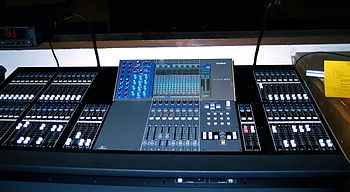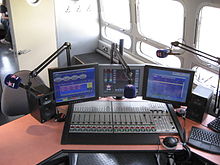- Digital mixing console
-
In professional audio, a Digital Mixing Console (DMC), is an electronic device for combining, routing, and changing the dynamics of digital audio samples. The digital audio samples are summed to produce a combined output. A professional digital mixing console is a dedicated desk or control surface produced exclusively for the task. Computers with specialized outboard gear may serve the function, with less control capability—fewer independent fader moves can be initiated at the same time.
Contents
Uses
Digital mixing consoles are typically used in recording studios, public address systems, sound reinforcement systems, broadcasting, television, and film post-production.
Solutions to common sound system problems
Assuming that an institution has an adequate sound system, a common problem is often the person operating the system! An institution can spend thousands on a state-of-the-art sound system but it is only as good as the person operating it. If the institution is fortunate enough to have a professional operator, he or she cannot always be there for every event.
A second major problem is the improper location of the equipment. The sound operator is often secluded in a closed in room, behind glass, etc. No sound operator can properly adjust a live sound system unless he or she can hear exactly like the majority of the audience.
The best solution to offset operator problems is to automate whenever possible. The advent of modern digital computer technology has now made it possible to install sound system components that will almost operate themselves. As one upgrades or installs a completely new sound system, they should try to obtain items that require as little hands-on, human operation, as possible.
Some digital mixers have analog style control features. Those older style manual slider and knob controls make the mixer more user friendly. Those controls however, are commanding a totally digital platform, much like desktop icons or shortcut icons control programs on a personal computer.
A digital mixer can offset the lack of sound operator expertise because it remembers what a person that knew what they were doing, told it to do. For example: A knowledgeable person can adjust all of the microphone settings, monitors, etc., for a given event. After everything is properly adjusted, that setup is assigned a name and stored in the memory. Afterward, a less knowledgeable operator can simply look on the computer screen or touch screen to recall that setting. Then, like some invisible man was operating the system, all of the controls move to their proper positions. Likewise, setups for any other events can be stored and instantly recalled.
One can easily program many different pre-set configurations or "snapshots," into the mixing console. Once a stored setting is recalled, the operator can still make manual volume adjustments, etc., without affecting the stored program. In other words, they can change a lot of stuff and all one has to do is hit the recall and the mixer automatically returns to all of the correct startup settings.
 Digidesign's Venue Profile mixer on location at a corporate event. This mixer allows plugins from third-party vendors. A Smaart software screen is partially shown on the right—Smaart allows plugins, too.
Digidesign's Venue Profile mixer on location at a corporate event. This mixer allows plugins from third-party vendors. A Smaart software screen is partially shown on the right—Smaart allows plugins, too.
Another advantage of this digital or computer type of mixing console is the abundance of control features that it provides for each microphone channel. It would take racks full of expensive gates, compressor limiters, equalizers, feedback controllers and other signal processing gear, to do what a modern digital mixer does internally. The elimination of all these outboard rack pieces, with all of their switches, knobs and connections, will make a system even less vulnerable to failure and outside interference.
Third-party plugins can add functionality in a digital mixer. Plugins allow for further expansion of the mixer's onboard equalization, compression and reverberation effects.
When mixing for recording purposes one can rely on headphones alone. The opposite is the case for live sound mixing. No sound operator can properly adjust a live sound system unless he can hear exactly like the majority of the audience. For issues related to space, appearance and security, one cannot always locate their sound control equipment, out in the middle of their auditorium. This is even more of a problem if the auditorium is a multi-use building that is often converted for other events.
A digital mixer can also solve this problem. A sound operator can operate the whole sound system from a laptop or desktop computer. With the proper setup, it can even be done by a wireless laptop configuration for increased mobility. In fact, many of the digital mixer's functions are easier to operate from the computer screen than the actual mixing console.
Using dual DMCs to improve live recording
In truly professional broadcast and recording applications, one does not use what is referred to as the house mix for high quality audio recordings. There is a simple reason for this. When one is engineering live sound for any auditorium, one must deal with the acoustic parameters of that particular auditorium. This requires various adjustments of equalization, bass, treble, volume, etc. While those adjustments may enhance the sound quality in the auditorium, they are not necessarily needed for the recording. In fact, those house mix adjustments often diminish the quality of the recorded sound. Once the bass, treble, volume and other effects of the house mix are added to the recording mix, it is most difficult to correct. In the reverse, adjustments and signal processing effects that are often used to enhance a recording mix are not always needed in the house mix.
Separating the house mix from the recording mix easily solves this problem. This is done with two mixing consoles and a transformer based microphone splitter and snake system. In simple terms, the wires from the house microphones are divided with transformers and sent to two separate mixers at the same time. Then, the operator of either mixer, house or recording, can access each of the house microphones as if they were the only one using it. The house mix adjustments will not affect the recording mix and vice versa. The outputs of the house mixer are designated to the live sound amplifiers and speakers. The outputs of the recording mixer are designated to the recording and/or broadcast equipment.
Advantages and disadvantages
Advantages
- There is no added noise, (unintentional) distortion, or other signal degradation while the signal is in the digital domain, between the output of the analog to digital converter (ADC) and the input to the digital to analog converter (DAC).
- Aux sends can be mixed on the main faders rather than on a row of potentiometers.
- Signal routing is often much more flexible than with an analog-based console.
- The setup of the console can be saved and loaded at will. This is particularly useful in live events where a setup for each band can be largely prepared in advance, saved, and then loaded as needed.
- There are typically many on-board effects and virtual signal processors available, eliminating the need for additional hardware modules, and the associated cost, size, weight, cabling, signal quality issues, etc.
Disadvantages
- There is an analog to digital conversion, then processing of the signal, then again digital to analog conversion, which degrades the sound quality. This is subject to debate, since the quality degradation is not always noticeable.
- The number of faders is often less than the number of input channels. The extra input channels are not accessible until a bank of faders is switched to control them.
- Digital conversion and processing adds latency, or delay, into the signal.
- The act of making adjustments is often slower for compact digital mixers which require the user to page through one or more layers of commands before reaching the desired control.
Popular product examples
- - Allen & Heath iLive
- - Cadac Electronics S-Digital
- - DiGiCo D1 Live, D5 Live, D5T, SD7, SD8, SD8-24, SD9
- - Avid D-Show Venue, D-Show Profile, and SC 48
- - Innovason SY48 and SY80
- - Klotz Digital's AEON and D.C.II, in the radio broadcast segment
- - Mackie TT24
- - Midas XL8, PRO9, PRO6, PRO3, PRO2/PRO2C, and the VeniceF series (analog console with digital I/O capabilities)
- - PreSonus StudioLive 16.0.2, 16.4.2 and 24.4.2
- - RML Labs Software Audio Console (SAC)
- - Roland M-380, M-400, Edirol M-16DX
- - Soundcraft Si1, Si2, Si3, Vi4 and Vi6
- - Studer Vista 8
- - Tascam DM3200 and DM4800
- - Yamaha 01V, LS9, M7CL, DM1000, DM2000, PM5D and PM1D
See also
Categories:
Wikimedia Foundation. 2010.


